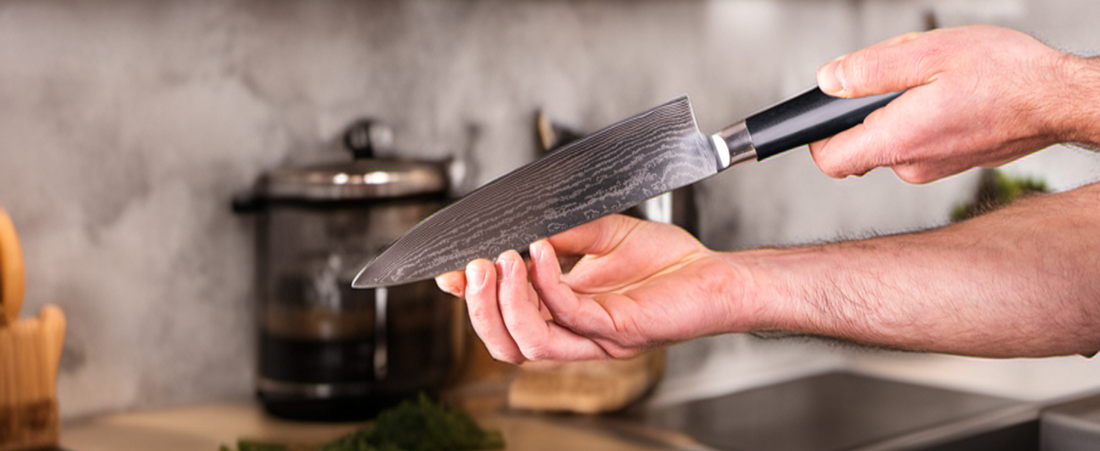Did you know that your dishwasher can gradually destroy the blade of your favourite kitchen knife? Regular washing in the dishwasher gradually causes micro-damage, corrosion and dulling of the blade - and you won't even notice! The result? Your knives lose their sharpness, wear out faster and cutting becomes tiring. Want to enjoy perfectly sharp knives for longer? Learn simple tips on how to protect your knives and why hand washing really is the better choice!
We're often tempted to throw dirty knives straight into the dishwasher - it's convenient. Unfortunately, the dishwasher is a real enemy to our knives. Experts and manufacturers warn that high temperatures, aggressive detergents and constant humidity inside the dishwasher can quickly destroy both the blade and handle of a knife. The effects include dull edges, rust stains and even cracked handles. Here we take a closer look at what happens when you put a kitchen knife in the dishwasher and how you can avoid it.
Blade: loss of sharpness and risk of corrosion
Aggressive dishwasher detergents are much stronger than dishwashing liquids - they can literally 'eat' the knife blade. The alkali and salt compounds they contain attack the steel, damaging the microscopic cutting edge and the protective anti-corrosion layer of the stainless steel. As a result, the knife gradually loses its sharpness and becomes more susceptible to rust. What's worse, many of these defects are initially invisible to the naked eye - the blade looks fine, but under a magnifying glass you can see micro-cracks and pitting. After just a few washes, the knife becomes harder to cut because the chemicals and pressurised water jets have dulled the edge.
High temperatures also accelerate these chemical processes. The hot, humid atmosphere of the dishwasher promotes corrosion - rust spots or dull discolouration can appear on the blade, especially if the knife remains damp after the cycle.
Knife shocking during the wash is another problem. If we place the knife in the cutlery basket or loosely on the shelf, it can bump into other cutlery or plates during the wash cycle. This can lead to chipping or bending of the edges.
Even minor micro-damage over time contributes to noticeable dulling. The rotating arms with nozzles in a dishwasher act like a water hammer on a knife - the constant vibration and impact of the water jets smoothes the sharp edge of the blade. It is a bit like constantly hitting metal with our knife: the sharpness disappears and the blade needs to be sharpened more quickly.
In summary, the knife blade suffers three times in the dishwasher: chemically (from the detergents), thermally (from the hot water) and mechanically (from the shocks). A knife that comes out of the dishwasher may look clean, but in reality it is slightly duller and weaker than before it was washed. Regular washing in such conditions will cause even the highest quality "stainless" steel knife to rust or become dull, and constant blunting will force us to sharpen it frequently (which in turn will wear away the blade material).

Handle and bolster: hidden damage
It's not just the blade that suffers in the dishwasher - the handle and where the blade joins the handle also suffer. With traditional wood-handled knives, prolonged soaking is a disaster: the wood absorbs moisture, swells and then dries unevenly, causing cracks and deformation. Aggressive chemicals from detergents also soften and wash out the natural oils from the wood, accelerating the destruction of its structure. As a result, the beautiful, smooth wooden handle can become rough, cracked and even start to fall apart at the edges.
Modern knives often have synthetic handles (plastic, composite). Unfortunately, they are not dishwasher safe. At high temperatures, the long chains of polymers that make up plastic begin to break down - the material loses its strength. This may not be visible at first, apart from a slight dulling of the handle colour, for example. Over time, however, the surface of the plastic handle may become covered with small cracks or a whitish coating (known as the "peeling" effect), indicating the degradation of the material. A weakened handle becomes brittle - dropping the knife on the floor can easily cause a piece of the handle to break off or break completely.
What happens where the blade meets the handle? If the knife is riveted or glued, the expansion and contraction of the materials under the influence of heat and water can loosen the joint. Water can get into the smallest gaps between the steel and the handle. There it can cause hidden corrosion - the steel pin and rivets can rust inside the frame, weakening the whole structure. A wooden handle that swells can in turn deform, causing it to loosen around the pin. The effect? The knife becomes unstable and the handle can even break off the blade during use - something we certainly want to avoid. In short, a knife handle that is washed in a dishwasher ages faster: it cracks, discolours, loses its shape and its secure attachment to the blade. This is not only a matter of aesthetics, but also of safety, as a damaged handle can lead to cuts or accidents.

Daily washing = quicker knife wear
If you put a good knife in the dishwasher once, it won't be ruined immediately - the damage is usually gradual. Therein lies the rub: because we don't see any drama after the first wash, many people start doing it regularly. However, putting a knife in the dishwasher every day is a direct route to premature wear and tear. Each wash adds another layer of micro-damage: the edge becomes increasingly rounded and blunt, small rust spots or discolouration can appear on the steel, and the handle gradually loses its properties. At first the changes are invisible, but after a while we will notice that the knife "doesn't cut like it used to" or that there are dull spots on the blade that weren't there before. Although the damage may not be immediately visible, the dishwasher will shorten the life of our knife - we simply won't enjoy it as long as we could. It can be compared to a dull razor: it shaves, but you have to rub it and the skin is still irritated. It's similar here - the knife seems to cut, but the dull one tires our hand and tears the products.
The more often a knife is washed in the dishwasher, the more often it needs to be sharpened to restore its effectiveness. Constant sharpening, in turn, wears down the blade material - the knife wears out geometrically faster. A knife that is washed daily in a dishwasher may need to be thrown away after a year, while the same knife washed by hand may last for many years. In the case of expensive, high-quality knives (which we often buy thinking that they are an investment that will last for years), such risky treatment is particularly unprofitable. In short, putting a knife through the dishwasher every day is a guarantee that it will quickly lose its utility value. It is better to save yourself the expense and nerves involved in prematurely replacing equipment.
How to care for kitchen knives instead of washing them in the dishwasher?
As the dishwasher is out of the question, it's worth knowing how to clean and store your knives to keep them safe and in good working order. Here are some basic rules for caring for kitchen knives:
- Hand wash immediately after use. It is best to wash the knife immediately after cutting, before the residue dries. Use warm water, a little mild washing-up liquid and a soft sponge or cloth. Gently wipe both sides of the blade (be careful of your fingers!), then rinse thoroughly with clean water. Note: Avoid scrubbing the blade with a rough sponge or wire brush - this can scratch the steel. Do not leave the knife dirty for a long time, especially after contact with acidic products (e.g. citrus fruits, vinegar, tomatoes), as acids can slowly damage the steel.
- Avoid prolonged soaking. Do not leave knives at the bottom of the sink or in a closed dishwasher. Prolonged exposure to moisture promotes corrosion of both the blade and the metal parts of the handle. Wooden handles also do not like to be soaked in water - it can cause them to crack. If you need to soak dried dirt, do so briefly and then wash and dry the knife immediately.
- Dry immediately after washing. After rinsing, dry the knife thoroughly with a clean cloth or paper towel. Do not leave the knife to dry on its own on the drainer - dried drops can cause water stains or even minor rusting (especially in the micro-cracks near the edge). Wiping by hand will also prevent accidental damage to the blade when it is lying in a pile of dishes. Remember that even stainless steel can become dull or rusty if water is left on it for a long time.
-
Store knives carefully. Avoid throwing a knife loose in a drawer full of cutlery - knocking it against other metal objects will quickly dull the edge. Instead, store knives separately: in a knife block, on a magnetic strip or in blade guards. That way, the blades won't touch and dull each other, and you won't cut yourself looking for something in the drawer. If you use a magnetic strip, hold the knife gently with the side of the blade rather than throwing it with the magnet - this will also prevent chipping.
-
Look after the handle. If you have a knife with a wooden handle, you can impregnate it with wood oil from time to time - this will prevent excessive drying and cracking. If you have a plastic handle, keep it clean and do not expose it to high temperatures for long periods of time (e.g. do not leave it next to a hot burner), as this will accelerate the ageing of the plastic. Check from time to time whether dirt or rust has accumulated between the blade and handle - if so, clean and dry these areas thoroughly.
-
Sharpen your knives regularly and properly. Even with the best care, every knife will eventually become dull. So when you invest in knives, remember that you also need to buy a good sharpening stone. Use it as soon as you start to have difficulty cutting, not when the knife is completely dull. Handle the knife carefully when sharpening and always wash it afterwards (metal particles can remain on the blade). Remember that a sharp knife is safer than a dull one - you use less force to cut, so there is less risk of slipping and accidents.


Summary
To conclude, the best chefs and knife manufacturers unanimously recommend hand washing. After using the knife, all you need is warm soapy water, a quick rinse and a wipe. This simple care will reward you with many years of reliable service, excellent sharpness and an elegant appearance - no rust, no cracks, no unpleasant surprises. It is better to spend a few seconds hand-washing the knife than to regret the damage later. Our knives will thank us (and our fingers will be fine!).

